
About UsThe Numismatic Bibliomania Society is a non-profit organization promoting numismatic literature. For more information please see our web site at coinbooks.org SubscriptionsThose wishing to become new E-Sylum subscribers (or wishing to Unsubscribe) can go to the following web page link MembershipThere is a membership application available on the web site Membership Application To join, print the application and return it with your check to the address printed on the application. Membership is only $15 to addresses in the U.S., $20 for First Class mail, and $25 elsewhere. For those without web access, write to: David M. Sundman, Secretary/TreasurerNumismatic Bibliomania
Society AsylumFor Asylum mailing address changes and other membership questions, contact David at this email address: dsundman@LittletonCoin.com SubmissionsTo submit items for publication in The E-Sylum, just Reply to this message, or write to the Editor at this address: whomren@coinlibrary.com
BUY THE BOOK BEFORE THE COINYou won't regret it! |
- WAYNE'S WORDS: THE E-SYLUM JULY 5, 2009
- NEW BOOK: THE PATTERN COINAGE OF PETER GETZ BY GEORGE FULD
- NEW CD BOOK: THE HAXBY STANDARD CATALOG OF UNITED STATES BANK NOTES
- BOOK REVIEW: A GUIDE BOOK OF WASHINGTON AND STATE QUARTERS
- CONDER TOKEN COLLECTOR'S JOURNAL SUMMER 2009 ISSUE
- THE COLONIAL NEWSLETTER AUGUST 2009 ISSUE
- BOOK REVIEW: GREEK AND ROMAN COINS FROM THE DU CHASTEL COLLECTION
- MORE ON HENRY MORGAN: A NUMISMATIC DETECTIVE STORY
- ROYAL MINT ERROR: THE DATELESS 2009 TWENTY PENCE
- MORE ON WHAT TO CALL A COIN OR MEDAL ARTIST
- CORRECTION: VICTOR DAVID BRENNER PROFILE
- MORE ON JAMES D. FOSKETT
- THE VICTORIAN INTERNET
- BRENNER ART OF THE MEDAL HALFTONE REPRINTS OFFERED
- MORE ON THE WATERLOO MEDAL(S)
- MORE ON U.S. COIN DENOMINATIONS
- EARTHQUAKE TOKENS AND MEDALS
- ANA ELECTION RESULTS: CLIFFORD MISHLER ELECTED PRESIDENT
- ANA EXHIBIT JUDGING COURSE OFFERED: YOU BE THE JUDGE!
- PROFILE: COMMEMORATIVE COIN DESIGNER ISAAC SCOTT HATHAWAY
- NEW MEDAL: THE ELIZABETH CROSS
- AUSTRIA'S SILVER PHILHARMONIC USED TO SKIRT TAX LAWS
- THE BAROON DOLLAR: NEW LOCAL CURRENCY IN QUEENSLAND, AUSTRALIA
- MORE ON THE SILVER DECA COINS OF ATLANTIS II
- DICK JOHNSON ON LOW-VALUE DEBIT CARDS
- FEATURED WEB SITE: ROMAN PROVINCIAL COINAGE ONLINE
WAYNE'S WORDS: THE E-SYLUM JULY 5, 2009
 We still have 1,233 subscribers - no one new this week.
We still have 1,233 subscribers - no one new this week.This week we open with word of an important numismatic discovery and a new book on the coinage of Peter Getz.
Next up is a new CD book of a long out-of-print classic on U.S. obsolete currency, and a review of the Whitman book on Washington quarters. Other books discussed are Greek and Roman Coins from the du Chastel Collection and The Mystery Of Henry Morgan: A Numismatic Detective Story.
On the periodical front was have information about the latest issues of the Conder Token Collector's Journal and The Colonial Newsletter.
New topics this week include earthquake tokens, the new Elizabeth Cross, the Baroon Dollar and low-value debit cards. To learn about the craze over the Royal Mint's dateless 20p coins, read on. Have a great week, everyone!
Wayne Homren
Numismatic Bibliomania Society
NEW BOOK: THE PATTERN COINAGE OF PETER GETZ BY GEORGE FULD
In 1797, President George Washington presented to Congressman Francis Preston a buffalo horn ladle containing a silver specimen of the 1797 Getz Masonic medal, Baker 288. The background for this presentation is told by a fascinating story now brought to light by members of the Abingdon Lodge #48 of A.F. & A. M. of Abingdon, VA.
A friendship between two young surveyors, William Preston and George Washington lasted with correspondence that took place until William’s death in 1783. Years later William’s son, Francis, met his father’s friend in Philadelphia, one being the President of the United States and the other the young Congressman from Virginia. Warm relations were established between the two men. As a token of their friendship, Washington had the horn of a buffalo produced as a trophy to Colonel Preston’s skills in hunting and presented it to Francis.
The horn was made into a ladle about thirteen inches long, and in the bowl was mounted a silver medal. This medal was the famed 1797 Getz Masonic medal, Baker 288 and a copy is shown herewith.

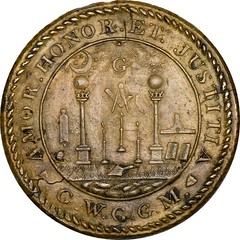
Many trials and tribulations occurred with the ladle and medal. It was lent by the family for the Centennial Celebration in Philadelphia in 1876. It was lost or stolen, and eventually recovered and returned in 1879 to Francis’ daughter, Mrs. John B. Floyd. Upon her death in 1879, she bequeathed the ladle to the Abingdon Lodge #48 of A. F. & A. M. in Abingdon, Va. When the lodge was in the process of moving its location in the 1960’s, it was lost again. Many years passed with no information, but in 1973 Chief of Police of Abingdon, William Phillips learned of its whereabouts and recovered the ladle. When returned, the medal in the bowl and a silver cap from the handle were missing.
In 2009, the Abingdon Lodge loaned the ladle to the Museum of the Grand Lodge of Virginia in Richmond. There is much more to this story. A complete background of the medal with illustrations is a chapter in the book, The Pattern Coinage of Peter Getz by George Fuld. The new book will be unveiled at the ANA Convention in August, 2009.
This publication details 22 different silver 1792 Getz patterns, 55 different copper 1792 Getz "cents" and 20 different 1797 Getz Masonic medals. Full backgrounds are supplied on each coin and they are mostly illustrated in color. A full discussion of the unique Getz Large Eagle "pattern", Baker 23 is given as well as the complete story about the Washington ladle. The books will be sold by George F. Kolbe of Crestline, CA.
NEW CD BOOK: THE HAXBY STANDARD CATALOG OF UNITED STATES BANK NOTES
Scott Tappa of Krause Publications writes:Hopefully this will allow people who have wanted to use this reference the chance to do it for a more affordable price. We’re really excited about this, and hope it goes over well with collectors!
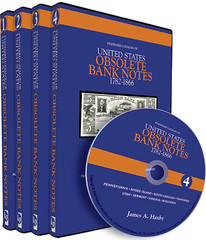 More than 20 years after its original release, the Standard Catalog of United States Obsolete Bank Notes 1782-1866 is once again available from Krause Publications, now as a four-CD set.
More than 20 years after its original release, the Standard Catalog of United States Obsolete Bank Notes 1782-1866 is once again available from Krause Publications, now as a four-CD set. With copies of the original four-book set nearly impossible to find and very costly to acquire, a large number of collectors have been without this all-inclusive and exceptionally detailed resource -- until now. In an attempt to bring James A. Haxby’s renowned reference to more collectors of U.S. bank notes, the numismatics team at Krause Publications has put together this phenomenal four-CD set, priced at $249.99.
"We are very excited to release the Haxby work in digital form," said Scott Tappa, numismatics publisher at Krause Publications. "If you own the four-book set, we hope these discs help you enjoy obsolete bank notes in an entirely different way. If this is your introduction to the work, prepare yourself for hours and hours of enjoyment and education."
This modern-version reissue of Haxby’s history-making work includes the entire volume in four Mac and PC-compatible CDs. While much has changed in the world and the hobby since this premiere resource was first published, and many of the prices may fall outside what a collector could expect to find in today’s market, there is no substitute for the historical details and identifying details found in the standard resource on U.S. obsolete bank notes.
Arranged alphabetically by state/territory and organized by bank name and cross referenced with bank branches, each section includes engraver imprint details, versions of notes, date of issue and hundreds of detailed photographs. The CD-pdf format allows users to search each disc using keywords or a handy index, and enables users to enlarge the pages up to 400% to provide a closer view of details and descriptions of notes. Plus, collectors can print select pages of listings, or notes by state to take to shows or club meetings.
Discover the excitement and intrigue of U.S obsolete bank notes again, or for the first time with this modern-day reissue of the legendary leader in obsolete bank note references.
For more information visit www.shopnumismaster.com/product/US-obsolete-bank-note-cds/us-paper-money
BOOK REVIEW: A GUIDE BOOK OF WASHINGTON AND STATE QUARTERS
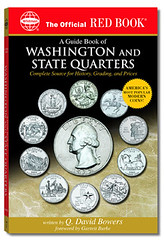 What better time than the Fourth of July weekend to review a book about the 50 States quarter series? Actually, it’s more than that - A Guide Book of Washington and State Quarters by Q. David Bowers covers all the Washington quarters from 1932 to date. A few weeks ago I reviewed another book on the State Quarter series, A Pocketful of History by Jim Noles. About the Noles book I wrote:
What better time than the Fourth of July weekend to review a book about the 50 States quarter series? Actually, it’s more than that - A Guide Book of Washington and State Quarters by Q. David Bowers covers all the Washington quarters from 1932 to date. A few weeks ago I reviewed another book on the State Quarter series, A Pocketful of History by Jim Noles. About the Noles book I wrote: This Official Red Book publication from Whitman fills that gap, adding all the requisite numismatic information on the series, and more. The review copy I have at hand stops with the 40th quarter in the series, South Dakota. I’ll have to pick up a newer edition someday. Curiously, I can’t find a publication date for this book in any of the usual places, but I have to assume it was in 2006. Lord, am I that far behind in my reading?
Anyway, the 288-page paperback lists for a modest $19.95 retail price. Images are in both black and white and color. Throughout are tables neatly listing mintages, certified grade populations and market values.
As expected, the book does illustrate the major known varieties such as the 1941 Doubled Die obverse and the 2004 Wisconsin "Extra Leaf" versions. A little under half of the book is devoted to the State Quarter series, with the rest covering the "original" Washington quarters – their history, design, die changes, minting and grading
The State Quarter portion is neatly organized into sections for each state with subsections covering the history and specifics of the chosen design. Interesting numismatic sidelights are provided in a subsection on "Numismatic Aspects" of each state. Here Bowers mentions and sometimes pictures other state related items such as civil war tokens, medals and paper money issues. The New Hampshire section illustrates a turnpike token featuring a design used as the inspiration for the state’s "Old Man of the Mountain" quarter.
I enjoyed the book and look forward to the updated version. Numismatic literature doesn’t have to be about only the old, rare and valuable coins – new issues are just as deserving of a scholarly treatment, and what better time to write such a book than in the present, when the coins are new and all of the players involved in their creation are still available to tell their stories.
CONDER TOKEN COLLECTOR'S JOURNAL SUMMER 2009 ISSUE
Editor Mike Grogan forwarded information about the summer 2009 issue of the Conder Token Collector's Journal, the official publication of the Conder Token Collector's Club (CTCC). The club is for collectors of 18th century British tradesmen's tokens, or "conder tokens".Contents of the issue include:
- Token Tales: James Sketchley, Freemason by R.C. Bell
- Recent Academic Literature by Tony Fox
- The Library,Conclusion by Richard Samuel
- Four New Varities of Camac Tokens by Gregg Silvis
- 2009 Seattle Congress Program by Bill McKivor
- Token Congress Photographs by Eric Holcomb
For more information on the CTCC, see: http://conderclub.homestead.com
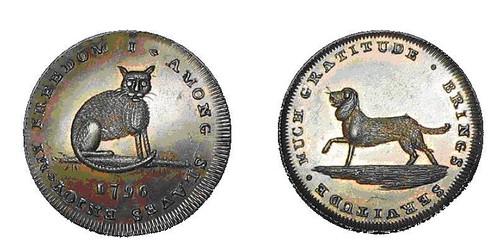
THE COLONIAL NEWSLETTER AUGUST 2009 ISSUE
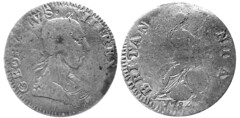 This issue starts with a paper that discusses the 1784-dated imitation British halfpenny known today as Batty 3826 or Vlack 14-84A. This coin is considered by many to be of American origin primarily because of its crude design.
This issue starts with a paper that discusses the 1784-dated imitation British halfpenny known today as Batty 3826 or Vlack 14-84A. This coin is considered by many to be of American origin primarily because of its crude design. Byron Weston carefully reconsiders the many aspects of this coin and argues that it is no different than many other British-made counterfeit halfpennies. Byron reviews what has been previously written about the coin, he provides many illustrations to support his discussion, and he introduces a new counterfeit halfpenny variety that appears to have been made by the same counterfeiting gang that produced Vlack 14-84A.
Byron references a little-known 1959 article by Eric Newman which has been reprinted in this issue for the enlightenment of our readers. The reprint follows Byron's paper and was first published in Empire Topics by Q. David Bowers.
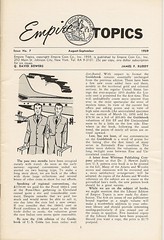
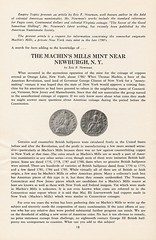
Next, we are pleased to welcome a new author, Max Spiegel, to the pages of CNL. Max writes about his investigations into the origin of Bermuda's hogge money. In He explores the possibility that Charles Anthony, the chief engraver at the Royal Mint in London from 1599 until his death in 1615, may have engraved the dies and privately minted hogge money for the Somers Isles Company. I won't spill the beans concerning what Max has determined. You will need to read Max's interesting and well-written paper to discover his conclusions.
Our final submission, in the form of a Technical Note, comes from Clem Schettino concerning a non-state coinage What'sIt?. Up to now, all known What'sIt?s have been re-engraved stated coppers.
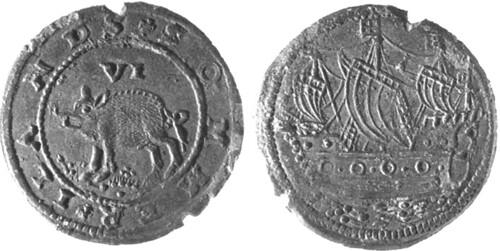
CNL is published three times a year by The American Numismatic Society, 75 Varick St., 11th Floor, New York, NY 10013. For inquires concerning CNL, please contact Megan Fenselau at the preceding postal address or e-mail fenselau@amnumsoc.org or telephone (212) 571-4470 ext. 1311.
BOOK REVIEW: GREEK AND ROMAN COINS FROM THE DU CHASTEL COLLECTION
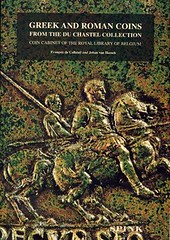 I recently won a copy of Greek and Roman Coins from the du Chastel Collection (Callataÿ & Heesch, Spink: London, 1999). Originally published at £60.00, it's now remaindered for £20 (about $33) from Spink. I got mine on eBay from Charles Davis who still starts auctions below wholesale.
I recently won a copy of Greek and Roman Coins from the du Chastel Collection (Callataÿ & Heesch, Spink: London, 1999). Originally published at £60.00, it's now remaindered for £20 (about $33) from Spink. I got mine on eBay from Charles Davis who still starts auctions below wholesale.It's a well-researched and well-made catalog of mostly Greek coins. The 41 plates are great. The 819 coins, collected by count du Chastel are all exceptional. Unfortunately in numismatic publishing, mere quality does not translate into sales. It's hard to compete with free color dealer catalogs. The best book in a category, such as Roman Republican Coinage (still in print at $490!) or Roman Provincial Coinage can move copies at high prices, while the second-best book doesn't move at all unless heavily discounted.
du Chastel is great but it's best feature is the superb dust jacket. The dust jacket photograph, by Stephen Sack, is the best I've ever seen on a coin catalog. It's an extreme closeup of the reverse of a sestertius of Nero, featuring the emperor on horseback. Sack manages to get an 8" picture out of the center of a 35mm coin that looks like an artistic masterpiece of detail and patina and light.
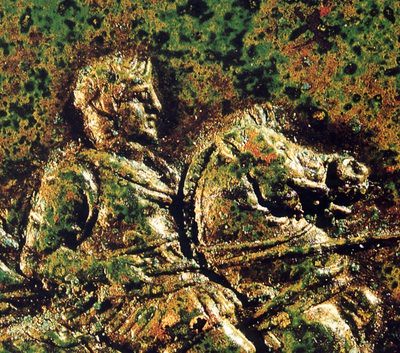
The image isn't photoshopped. My understanding is that he spent months looking at hundreds of worn bronzes with interesting patinas under a microscope looking for the textures and images that eventually make it into his work.
Sack had a show of his fine-art coin photography at the British Museum. The catalog, Metal Mirror: Coin Photographs by Stephen Sack is mind-blowing. Although I missed the London premiere I saw the pieces at Ariel Meyerowitz Gallery in New York. Very impressive.
I believe the Ariel Meyerowitz Gallery is gone but a few of Sacks' coin works can are available on VCoins, like this peacock and this goddess.
I can't afford a €4,000.00 picture of a peacock no matter how much I might want it, though. I bought a second copy of the catalog intending to dismember it and mount several images in 8x10 frames. I couldn't bring myself to take the blade to the duplicate catalog, though!
To read the complete article, see: Greek and Roman Coins from the du Chastel Collection (http://digitalhn.blogspot.com/2009/07
greek-and-roman-coins-from-du-chastel.html)
THE BOOK BAZARRE
MORE ON HENRY MORGAN: A NUMISMATIC DETECTIVE STORY
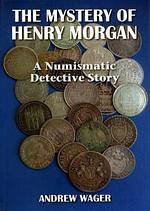 Shipping to the States costs me about £6 or £7 but I would be prepared to subsidise this for readers of your newsletter as I am keen to encourage more people in the States to get hold of it. So far Bill Mcivor took six copies over but has I understand sold all these.
Shipping to the States costs me about £6 or £7 but I would be prepared to subsidise this for readers of your newsletter as I am keen to encourage more people in the States to get hold of it. So far Bill Mcivor took six copies over but has I understand sold all these. The cost would therefore be £22 including postage (normally 19.99 retail not including post) if ordered directly from me. Payment could be by Paypal or sterling. My email address is barkhams@btinternet.com .
Phil Mernick in his kind comments about me got the true identity of Morgan wrong which he was doing from memory of my talk: I have encouraged, so far successfully, reviewers not to reveal Morgan's identity so as to make the book a better read like a detective story when "who did it" is revealed at the end.
To read the earlier E-Sylum articles, see: QUERY: THE MYSTERY OF HENRY MORGAN: A NUMISMATIC DETECTIVE STORY (www.coinbooks.org/esylum_v12n06a16.html)
MORE ON THE MYSTERY OF HENRY MORGAN: A NUMISMATIC DETECTIVE STORY (www.coinbooks.org/esylum_v12n07a07.html)
ROYAL MINT ERROR: THE DATELESS 2009 TWENTY PENCE
The blunder occurred after a redesign of the 20p piece. The Mint does not know exactly how many undated coins were produced and released into circulation, but estimates range between 50,000 and 200,000. This is the first undated British coin to enter circulation in more than 300 years - the last occasion was 1672, when Charles II was on the throne
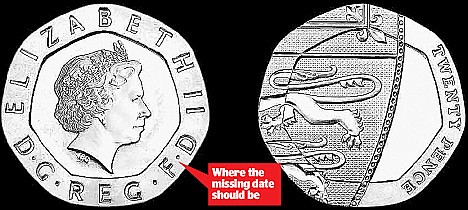
The Royal Mint's usually impeccable quality control somehow slipped up and the so-called 'mule' escaped into circulation. A 'mule' is a coin that has mismatched sides - a reference to the mule being a mismatch of a horse and donkey. The change of the 20p design
However, thousands of coins were minted using the old version of the Queen's head, which does not have the year date, and the new version of the tails side, which also does not have a date.
To read the Daily Mail article, see: Have you got a 20p worth £50 in your pocket? Thousands of undated coins produced in Royal Mint blunder (http://www.dailymail.co.uk/news/article-1196176
/Have-20p-worth-50-pocket-Royal-Mint-error-results-undated-coins.html)
 PEOPLE across Southport will be scouring for loose change after a student from Kew found a rare 20p coin – which could be worth more than £7,000!
PEOPLE across Southport will be scouring for loose change after a student from Kew found a rare 20p coin – which could be worth more than £7,000!Amy Cowperthwaite, who works at Subway on Eastbank Street, found the coin in the till, when she came into work for her eight-hour shift on Tuesday morning.
A rare error at the Royal Mint means that tens of thousands of the 20p coins produced earlier this year don’t have 2009 stamped on them.
Coin experts at the London Mint Office say the lack of a date makes them worth £50 each, but auction site eBay has seen thousands of people posting their rare coins, hoping to make a mint, with one fetching the hefty price of £7,100.
Team leader Amy said: "My mum had shown me an article about the coins in the paper and when I went into work the next morning, I thought it would be funny to see if we had any.
"I must have only searched about two bags when I found one without the date. We searched about £150 of bags but we didn’t find any more."
To read the complete Southport Visitor article, see: Southport student hopes to cash in with undated 20p coin (http://www.southportvisiter.co.uk/southport-news/
southport-southport-news/2009/07/03/southport-student-hopes-to-cash
-in-with-undated-20p-coin-101022-24060496/)
But it turns out that the seemingly generous offer, which had Britons scouring their wallets and purses in the hope of finding one of the elusive coins, is one that savvy consumers should refuse.
Several specialist coin dealers told The Independent yesterday that the 20p pieces could be worth up to £300 within five or 10 years, especially if they were kept in good condition and turn out to be particularly scarce.
The £50 offer was made by a privately owned company called the London Mint Office, which has no connection to the Royal Mint.
Chris Perkins, a coin specialist and author of the book Check Your Change, said he first became aware of the faulty 20p pieces at the end of 2008, but that they had largely escaped the attention of the general public until now. He owns two of the coins himself, for which he paid between £30 and £40 each, but added that their future value depended "on the hype" surrounding them.
"What I expect the London Mint Company will do is hype it up massively and then start knocking them out for £100 or £150," he said. "Poor old ladies who don't know much about it will be ones that buy them."
To read the complete article, see: Why 20p in the hand may be worth £300 (http://www.independent.co.uk/news/uk/home-news
/why-20p-in-the-hand-may-be-worth-163300-1724456.html)
MORE ON WHAT TO CALL A COIN OR MEDAL ARTIST
Regarding Dick Johnson's essay on what to call an artist who creates coins or medals, Harry Waterson writes:I found your E-sylum article very informative. It is a problem I have been wrestling with vis-a-vis Julio Kilenyi. I found this in an interview with Kilenyi in the Dec. 25th, 1937 issue of THE NEW YORKER. The interviewer ended his profile on this note:
In this vein, I have wondered if your publication THE ART MEDALIST was your attempt to add a new word to the language. Your editorial in the first issue did not explain the derivation of the title. However, the caption to the picture on the front page offered a clue. Frank Elescu and Mico Kaufman were identified as sculptors and William T. Louth, President of Medallic Art Co. as a medalist. So context identified Louth as the maker of the medal after the sculptors were done.
To read the earlier E-Sylum article, see: VOCABULARY WORDS: WHAT DO YOU CALL A COIN OR MEDAL ARTIST? (www.coinbooks.org/esylum_v12n26a12.html)
CORRECTION: VICTOR DAVID BRENNER PROFILE
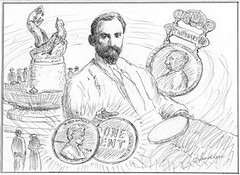 I read the snippet about Victor Brenner which referenced my book, and I want to correct a few errors. This is the only one of my Complete Guide books which has never been updated, despite any claims by the current publisher and book dealers. There has never been more than one edition (1996), though it has gone through various printings, each one a bit poorer than the previous. As I have no interest in updating this title, I'm hoping that it will simply go out of print at some point.
I read the snippet about Victor Brenner which referenced my book, and I want to correct a few errors. This is the only one of my Complete Guide books which has never been updated, despite any claims by the current publisher and book dealers. There has never been more than one edition (1996), though it has gone through various printings, each one a bit poorer than the previous. As I have no interest in updating this title, I'm hoping that it will simply go out of print at some point.In the nearly fifteen years which have passed since I wrote that book, some of the biographical information on Brenner has been refuted (there's that word again). I believe it was Bob Julian who exposed the falsehood of Brenner having been born Viktoras Barnauskus. It appears that he was always Victor Brenner, though I suspect that the European spelling would have been Viktor.
The article contained another obvious error in that Charles Barber did not retire; he died still in office in 1917. That was stated correctly in my book, and the author of the article cited must have just assumed that he retired. The tale of Brenner being imprisoned for making a duplicate seal and having to escape to America is almost certainly nonsense and should be stored in the same locker as Washington's chopping down of the cherry tree.
To read the earlier E-Sylum article, see: NEWSPAPER PROFILES COIN DESIGNER VICTOR DAVID BRENNER (www.coinbooks.org/esylum_v12n26a08.html)
Dave Lange adds:
MORE ON JAMES D. FOSKETT
Regarding our questions about the first librarian of the American Numismatic Society, Pete Smith writes:A James D. Foskett apears in the 1850 U.S. Census in New York City. He was born around 1830 in Massachusetts. He would be young to sell a coin collection in 1859, but still ten years older than cataloguer Augustus B. Sage.
The 1870 U. S. Census has the same James D. Foskett living in Suffolk. Massachusetts. The name James Foskett, without a middle initial, is common enough to be difficult to research.
THE VICTORIAN INTERNET
Regarding the Optical Telegraph mentioned last week, Bob Knepper writes: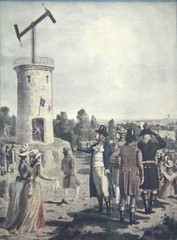 A more complete coverage of the "telegraph" systems before the electrical telegraph is in The Victorian Internet by Tom Standage (ISBN 0-425-17169-8). Per the suggestion of a friend, I borrowed and read it.
A more complete coverage of the "telegraph" systems before the electrical telegraph is in The Victorian Internet by Tom Standage (ISBN 0-425-17169-8). Per the suggestion of a friend, I borrowed and read it.Rather than the telegraph arms having 9,999 possible positions to define the individual words, most of the many different systems transmitted digits via arm positions, flags, etc. and then a multidigit number defined a word in a codebook. Although as the E-Sylum article said, the systems were fast compared to previous communication, the staffing requirements made them expensive and they were almost exclusively for government use.
THE BOOK BAZARRE
BRENNER ART OF THE MEDAL HALFTONE REPRINTS OFFERED
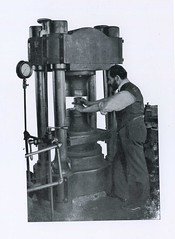

The group of 7 reprints were made in an edition of 30, as a donation to the ANA Library Fund by George Cuhaj and printed on an old letterpress in Waupaca Wisconsin. (See George at the press and other photos on his Facebook page - George Cuhaj)
E-Sylum readers can purchase a set by sending an 80.00 check made out to ANA, and mail it to Ryann Scott, ANA Librarian, 818 N. Cascade Ave. Colorado Springs, Colorado, 80903.
MORE ON THE WATERLOO MEDAL(S)
Pete Smith writes:
Darryl Atchison writes:
However, I could not understand where this medal came from nor how the family could claim that their ancestor had been awarded the medal. Pistrucci worked on the illustrated "Waterloo medal" for over three decades and it is unquestionably the legacy of his lifetime's work with the Royal Mint.
It is my understanding, however, that the dies that Pistrucci finally produced were deemed to be too large to strike from without risk of damaging them. Electrotypes were prepared of the Waterloo medal but this was sometime in the 1850s. I do not know whether any proof or specimen pieces were struck from the dies but there were definitely no pieces struck for presentation.
Sadly what has happened here is a mixup in photographs. There is a military decoration known as the "Waterloo medal" which was issued with a suspension loop and ribbon. The medals were presented to all ranks who had served at the battles of Ligny, Quatre Bras and Waterloo from June 16th - 18th, 1815. Clearly it is an example of this decoration which the family are putting up for auction and not one of Pistrucci's pieces.
Sorry to be the bearer of bad news but this is simply an editorial mixup. I wouldn't let this bother you too much. It made for interesting reading and prompted me to go and relearn a bit more about both Waterloo medals again.
Keep up the great work. I look forward to reading The E-Sylum every Monday morning.
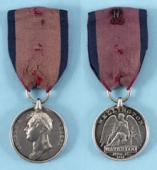 William Smith also wrote in questioning the illustration. The editorial mixup in this case was all mine – the original article didn’t have an illustration of the piece in question, and I grabbed an image of the Pistrucci Waterloo medal from the E-Sylum archives. Oops – my mistake. Thanks for setting us straight. Darryl noted that images of the OTHER Waterloo medal are readily available on the internet. Here's one image I found, and Darryl confirms this is the likely type of Waterloo medal being auctioned. -Editor
William Smith also wrote in questioning the illustration. The editorial mixup in this case was all mine – the original article didn’t have an illustration of the piece in question, and I grabbed an image of the Pistrucci Waterloo medal from the E-Sylum archives. Oops – my mistake. Thanks for setting us straight. Darryl noted that images of the OTHER Waterloo medal are readily available on the internet. Here's one image I found, and Darryl confirms this is the likely type of Waterloo medal being auctioned. -Editor MORE ON U.S. COIN DENOMINATIONS
Regarding the statement that "The United States' earliest "real coins" (silver and gold) did not carry a denomination", David Gladfelter writes:I did check the Mint Act of April 2, 1792. It calls for placement of a denominational value only on the copper coins (sec. 10), but does call for certain devices and legends on all coins (ibid.) Other than that, it was up to the chief coiner to cause coins to be minted "according to such regulations as shall be prescribed by this or any future law," and up to the engraver to prepare dies "with the proper devices and inscriptions" (sec. 3).
Designs incorporating denominational values (and all required devices and legends) could have been prepared for all silver and gold coins, but they were not, with the exceptions noted above. Later acts did require denominational values to be placed on all coins, together with additional inscriptions (e.g. "In God we trust").
To read the earlier E-Sylum article, see: MORE ON U.S. COIN DENOMINATIONS (www.coinbooks.org/esylum_v12n26a14.html)
EARTHQUAKE TOKENS AND MEDALS
Earthquakes are extremely common in Alaska. Most are not felt, but are recorded by sensitive instruments. The ones we felt at the house were only 3+ according to the newspaper. That is quite small to shake the whole house, so I went on line to the Alaska Earthquake Information Center (http://www.aeic.alaska.edu/Seis/recenteqs/index.html) to see where the epicenters were. They were 1 to 3 miles SE and SSE of Ester, a small bastion of liberalism 10 miles outside of Fairbanks.
Our house overlooks the Ester valley, so I knew we were close. A customer who works at the Geophysical Institute at UAF studying volcanoes came in. While he is a volcanologist, he is in close contact with the people who study earthquakes. I showed him on a map where we live, and he said that we were pretty much on top of the epicenter, about a mile or so away.
There have been over 50 quakes on this previously little known fault line since before the first one that we felt. All but a few went unnoticed by the general population. They have since died down, but if they start up again, I may have a seismometer installed at the house by the folks at Gee-Whiz, as our location makes nearly a perfect triangle with two others they have in the field.
And with the shaking going on, I thought it would be a good time to note the 45th anniversary of the "big one" in 1964. There were several medals and tokens struck making note of this massive quake. This earthquake, originally rated at 8.4, has been re-evaluated and placed at 9.2, the seconded largest ever recorded (http://www.aeic.alaska.edu/quakes/Alaska_1964_earthquake.html).
The most common earthquake medal is shown below. This was made in cupronickel (both bright and oxidized), bronze and brass. I have to believe it was also made in silver, but I have not seen one. It is 40mm and looks like a Wendells product.
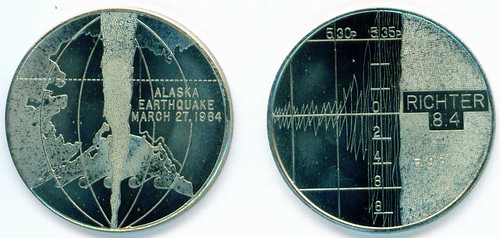
THE BOOK BAZARRE
ANA ELECTION RESULTS: CLIFFORD MISHLER ELECTED PRESIDENT
- President: Clifford Mishler
- Vice President: Thomas G. Hallenbeck
Governors:
- Joseph E. Boling
- Jeff C. Garrett
- Chester L. Krause
- J.P. Martin
- Walter A. Ostromecki
- Scott T. Rottinghaus
- Wendell A. Wolka
Unsuccessful Candidates for Governor
- Michael L. Ellis
- Brian E. Fanton
- Alan Herbert
- Paul Hollis
- Thomas A. Palmer, Jr.
- Jeffrey Swindling
- Michael S. Turrini
To read the complete press release, see: CLIFFORD MISHLER ELECTED ANA PRESIDENT (http://www.money.org/AM/Template.cfm?Section=Home
&CONTENTID=14769&TEMPLATE=/CM/ContentDisplay.cfm)
ANA EXHIBIT JUDGING COURSE OFFERED: YOU BE THE JUDGE!
Exhibiting will be one of the truly educational dimensions of the ANA World's Fair of Money to be held in Los Angeles, August 5-9. A number of E-Sylum readers will bring their prized material to that show to educate other collectors as well as the public. Some exhibit non-competitively, but the majority of exhibitors are driven by their competitive juices to vie for numismatic honors on behalf of their holdings.Some of you are the very judges who evaluate exhibits for first, second, and third place prizes as well as the several other awards, including the prestigious Howland Wood Best in Show honor. Chief Judge Sam Deep asks the rest of you to consider joining with the current group of experts in their respective field who will umpire over 100 exhibits this year. Judges are quite literally a dying breed and our hobby needs your help.
Sam offers a two-hour course on Wednesday at 10AM in LA that will ready you for the job. After practicing your skills on a few of the exhibits, you and he can then decide whether it's a calling that you will continue at future conventions. Email Sam at deepsam@aol.com with your questions or to sign up for the Judge's Familiarization and Certification Program next month.
PROFILE: COMMEMORATIVE COIN DESIGNER ISAAC SCOTT HATHAWAY
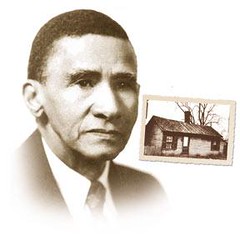 His classmates called him "Big Boots" because he had no shoes and wore his father's Army combat boots to school.
His classmates called him "Big Boots" because he had no shoes and wore his father's Army combat boots to school.Isaac Scott Hathaway was born April 4, 1872, the son of a Civil War veteran, Robert Elijah Hathaway, who had proudly served as a member of the United States Colored Troops. When Hathaway was only 2 years old, his mother, Rachel Scott Hathaway, died, and the children were raised by their father and grandparents.
At the age of 9, Hathaway stated that he would become the sculptor of busts of "famous Negroes" after he found none displayed in a gallery.
Hathaway frequently visited the Thoroughbred race and trotting tracks in Lexington, not to bet on the horses but to draw and paint them. A news article in 1897 listed the horses he had painted for wealthy patrons of the industries. Only one of the paintings is known to have survived: one of Queen Ban, completed in 1896.
After graduating in 1891, Hathaway became a teacher at Keene in Jessamine County – a profession that he continued until his retirement in 1966. All the time he taught, he also pursued his other passion – creating busts of famous African Americans and placing them where people could see them. Hathaway received advanced training in the arts at the New England Conservatory in Massachusetts and the Cincinnati Art Academy. He returned to Lexington after his studies and began perfecting his skills. In 1900, he opened his first studio of sculpture in that chicken coop behind his birth home.
He requested and was granted permission to take the death mask of Cassius Marcellus Clay, famed Kentucky emancipationist and former United States Ambassador to Russia; he later created a heroic-sized bust.
Near the end of 1907 Hathaway moved to Washington, D.C., where he and other partners founded the Afro-Art Company. During his Washington years, he produced 12-inch busts of Paul Laurence Dunbar, Booker T. Washington, Bishop Richard Allen and Frederick Douglass. His work of the time period was cited in "The Artists of Washington, D.C. 1796 – 1996," by Virgil E. McMahah.
In his lifetime, Hathaway produced over 100 busts and masks of African Americans in all disciplines. His sculptures are at scattered in public institutions across the country, as well as in private collections.
Hathaway is the only African American to be commissioned by the United States Mint to design the molds for two commemorative coins honoring great African Americans: Booker T. Washington, educator and president of the Tuskegee Institute, and George Washington Carver, educator and scientist at Tuskegee – both of whom Hathaway personally knew. The coins were produced from 1946 to 1954. Hathaway's achievement as the only designer of two coins now stands as a record of 63 years.
To read the complete article, see: "Big Boots" pulls himself up (www.southsidermagazine.com/Articles-c-
2009-06-29-87989.113117_Big_Boots_pulls_himself_up.html)
NEW MEDAL: THE ELIZABETH CROSS
They are not just any honours, however. The introduction of each of these awards, and the decision by Victoria, George VI and now Elizabeth to lend their names to them, reflects a series of fundamental shifts in society’s attitude to duty, sacrifice and the role in our national life played by both the Armed Forces and the civilian population.
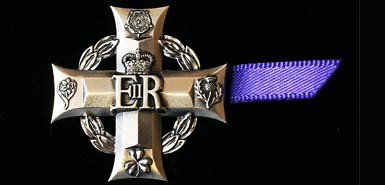
Hard though it may be to imagine now, before the Victoria Cross there was no gallantry medal for anyone below the rank of major, or a captain in the Navy.
Officers of the appropriate rank were awarded the Companionship of the Order of the Bath: the rest got nothing.
Victoria recognised the valour of the other ranks, George VI the gallantry of civilians facing a war on the home front: now Elizabeth has chosen as her legacy the recognition of the sacrifice made by families whose loved ones have died in the course of duty. While the initiative came from the defence chiefs, the Queen played an active part in the discussions, and it was her suggestion that it be called the Elizabeth Cross.
That she should be so involved is entirely in character; not only is she the only living monarch to have served in uniform in the Second World War — she was in the ATS — but she has also had a long and close involvement with the Armed Forces.
From Cyprus to Northern Ireland, from the Falklands to Afghanistan and Iraq, conflicts both home and overseas have been, in the words of one aide, "at the forefront of her mind throughout her reign".
The Queen has, over the years, heard many moving stories of the deaths of servicemen and women, the aide said. "This is her legacy."
To read the complete article, see: Elizabeth Cross follows a tradition that started with Crimean War (http://www.timesonline.co.uk/tol/news/uk/article6620202.ece)
The MoD says that by August it will trace all next of kin of those killed as far back as 2000; everyone else should apply. "But they have all my details now," says Mrs Smith, "so why haven't they been in touch? It seems pretty shambolic to me."
Tony Philippson, whose son James was killed when he was ambushed in Afghanistan in 2006, heard about the Elizabeth Cross through a text message from his son's Colonel. "I got the text about an hour ago," he said. "I don't really know anything about it. I don't suppose it really matters that they consult me, but it would be nice to to learn about it before it is in the newspaper."
To read the complete article, see: The Elizabeth Cross: Is it too little, too late? (www.telegraph.co.uk/news/uknews/5724472/The-Elizabeth-Cross-Is-it-too-little-too-late.html)
AUSTRIA'S SILVER PHILHARMONIC USED TO SKIRT TAX LAWS
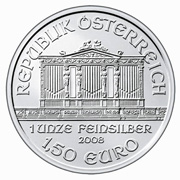 Hot tip for German investors: an Austrian silver coin that can be smuggled legally. It's music to the ears of Germans who bank in Austria. But how long can the party last?
Hot tip for German investors: an Austrian silver coin that can be smuggled legally. It's music to the ears of Germans who bank in Austria. But how long can the party last?The object of desire is 37 millimetres in diameter and made of .999 fine silver. On one side, the coin shows an organ, its country of origin ("The Republic of Austria") and its face value: €1.50 ($2.12). On the flipside: "Vienna Philharmonic Silver" and a few musical instruments from the world famous orchestra.
The coin, known to numismatics as the "Silver Philharmonic," could well drive Germany's already harassed Finance Minister Peer Steinbrück over the edge. Because the ounce of silver is a hot tip among German investors -- and a means of discretely transferring untaxed funds back home.
The story of its success has to do with a funny little contradiction: As a means of payment with a value of €1.50, the coin can be used to buy a beer. But nobody in his right mind will take it to the pub in the first place because the exclusive silver piece is worth -- depending on the price of silver --somewhere between €11 ($16) and €14 ($20), and costs that much at the teller's window.
It's this difference between the face and market values of the coin that makes it so attractive in the context of international money transfers. The coin manages -- astonishingly -- to circumvent currency import regulations. A person travelling from Austria to Germany is allowed to bring €10,000 ($14,000) into the country without having to declare it at customs. So that person can bring more than 6,000 Philharmonic coins over the border and in doing so, bring home, with each trip, more than €110,000 ($156,000) of his hidden Austrian treasure.
To read the complete article, see: A New Austrian Coin Trick (http://www.spiegel.de/international/europe/0,1518,633772,00.html)
THE BAROON DOLLAR: NEW LOCAL CURRENCY IN QUEENSLAND, AUSTRALIA
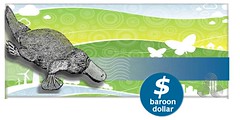 The Baroon Dollar is a community or complementary currency launching in August 2009, which will be redeemable for goods or services within the Blackall Range and Sunshine Coast Hinterland region of Queensland, Australia. It is an initiative of Sustainable Maleny and the Australian Institute for Community Currencies Inc - a non-profit community organisation.
The Baroon Dollar is a community or complementary currency launching in August 2009, which will be redeemable for goods or services within the Blackall Range and Sunshine Coast Hinterland region of Queensland, Australia. It is an initiative of Sustainable Maleny and the Australian Institute for Community Currencies Inc - a non-profit community organisation.Baroon Dollars are gift certificates or payment vouchers. You will be able to buy the Baroon Dollar from this site or distribution centres across the Sunshine Coast Hinterland. When you buy a Baroon Dollar you’ll be buying a gift certificate from the Australian Institute for Community Currencies Inc which is redeemable for goods and services across the Hinterland. Baroon Dollars are not a replacement for the Australian dollar, but a complementary tool to support the local economy and to raise awareness of the need to buy locally.
Darren Mitchell writes:
The designs of the notes are being kept under wraps. From the Baroon Dollar blog:
Philip recommended this article about the currency - here's an excerpt.
In 2004 Maleny locals made headlines for trying to stop the construction of a Woolworths on the banks of the town's Obi Obi Creek, which was a platypus habitat.
After long stand-offs, they lost that battle and the supermarket was built.
But this time they have taken on a bigger opponent and have decided to hit back at the global financial crisis.
They are going to print their own money.
The Baroon Dollar - named after Lake Baroon near Maleny - will be printed and sold at local, independent businesses to encourage locals and visitors to keep buying up locally.
To read the complete article, see: Money worries: town prints its own (www.abc.net.au/news/stories/2009/06/10/2594106.htm)
For more information, see: The Baroon Dollar (http://www.baroondollar.org/)
MORE ON THE SILVER DECA COINS OF ATLANTIS II
A few weeks ago I asked about the coins issued by the "Atlantis II" group.The schemers had their own silver coin, dubbed the "deca"; they got some press in Esquire; and they had their own homemade boat. But the ship sank in a hurricane, attention from the Haitian government forced the project into quiet mode (canceling the highly entertaining newsletter Atlantis News), and no new libertarian Atlantis ever arose in the Caribbean.
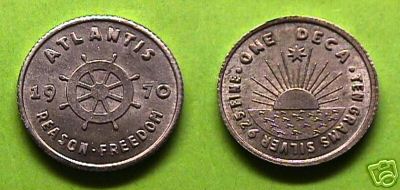
To read the earlier E-Sylum article, see: QUERY: THE SILVER DECA COIN OF ATLANTIS II (http://www.coinbooks.org/esylum_v12n24a17.html)
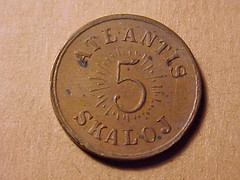
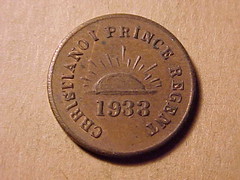
It is tentatively speculated that the term employed for the coins' denomination may have a linguistic connection to Esperanto: whereby a "skalo" (adding the "j" renders it plural) is a scale of measurement — a system of ordered marks at fixed intervals; a calibrated line; a progressive classification, as of size, amount, importance, or rank (e.g. a wage scale, a musical scale, the scale on a map).
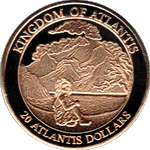
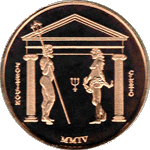
Oded writes:
I commend and applaud Mr. Moschetti's decisively bold transition into the designing and minting of his own patterns. I purchased the copper MMIV 20 Atlantis Dollars, but there are also a silver and gold 100 Atlantis Dollars. The obverse "features a small girl perhaps one of Poseidon’s children in the foreground with lake and mountains in background." The reverse "features Poseidon, the God of Atlantis along with his mortal wife Cleito standing in front of the Golden Gates of Atlantis."
Mr. Moschetti would go on to issue additional versions of the popular 20/100 Atlantis Dollars (the obverse being the only side that is markedly different): the 2007 edition features "two Atlantis boatsmen in their outrigger", and the 2009 edition features an "Atlantis woman bathing in a lake, with a waterfall in front of her. A Temple appears on the upper left part of the background."
Images of Atlantis' coinage can be viewed at the Coin Library of the USNS: http://www.usns.info/coin-atlantiskingdom.html They can also be seen at the Web-site of Mr. Jorge Fernández Vidal: http://www.jfvcoins.com/Productos/micronations_english=catAC.html
DICK JOHNSON ON LOW-VALUE DEBIT CARDS
They want to replace using coins with a card system and are inching their way into the vending machine industry. Where they have been most successful is in the self-service Laundromat industry. By retrofitting coin-operated Laundromat machines, the machines accept payment by a card (in effect a debit card). At the same location they supply a kiosk (they call an X-Changer) where you obtain or apply money to a debit card by increments of $5 (lowest amount acceptable) with $5 bills. Thus the use of coins in all denominations are entirely eliminated. We object to this.
We have no criticism of credit cards. These are generally used for high-value transactions, these are often in odd-cent amounts, accumulated during the month and billed in odd-cent amounts. No problem. Low-value debit cards, on the other hand, are specifically intended to replace the use of coins - a bad precedent for coin collectors.
The movement using low-value debit cards is insidious, a parasite eating away at the proper use of coins. Laundromats and public use photocopy machines are where these operators have made the greatest inroads. Their use is growing, a little at a time.
The greatest ill of debit cards is the unused portion. There is always a positive balance, no product delivered or service rendered to a zero balance -- causing, in effect, dead money! It cannot be used until the next transaction in that location. Never dead money with coins, they are universally accepted by every vendor, by every person in America.
What can coin collectors do? Do not patronize stores that use debit cards exclusively. Let the management know why. Write letters to the editor. A time honored way is to express your opinion in newspapers. And the most modern way is to hit the blogs. The influence of the internet is increasing.
Remember, as coin collectors, we have 2,000 years of coin-use heritage on our side. We also have the U.S. Constitution which granted the power of Congress to create coins. They were intended for just such use as at the local Laundromat.
To see the "face" of the enemy click on: www.laundrycard.com
Dick is curious to learn of other uses of debit cards replacing coins. I learned of an example of the unused portion problem this evening. My father in law discovered a Visa card he'd been given for his 80th birthday - two years ago.
It had an original $25 value, but now is worthless. After a year, the company starts deducting $3 a month whether the card is used or not. Real cash isn't printed with disappearing ink, and would still be just as good as it was on his birthday. But all he could do was give the card to my daughter Hannah to play with. Let's go shopping (her favorite game with Daddy lately)! -Editor
FEATURED WEB SITE: ROMAN PROVINCIAL COINAGE ONLINE
This week's Featured Web site is Roman Provincial Coinage Online.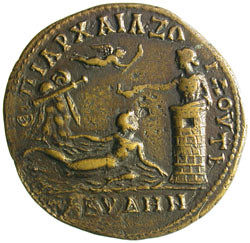
The database is based on the ten most important and accessible collections in the world, and on all published material. It comprises one of the largest collections of images and related inscriptions from the ancient world which is searchable by iconography, place, and time.
The database contains information on 13,729 coin types, based on 46,725 specimens (9,061 of which have images).
rpc.ashmus.ox.ac.uk
